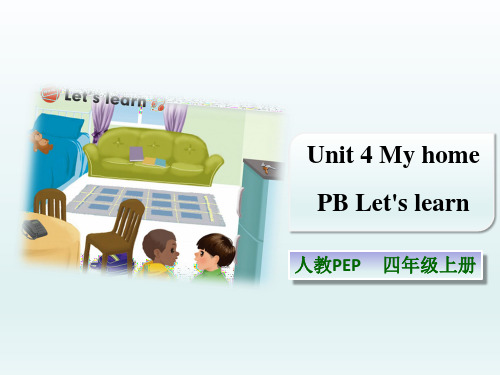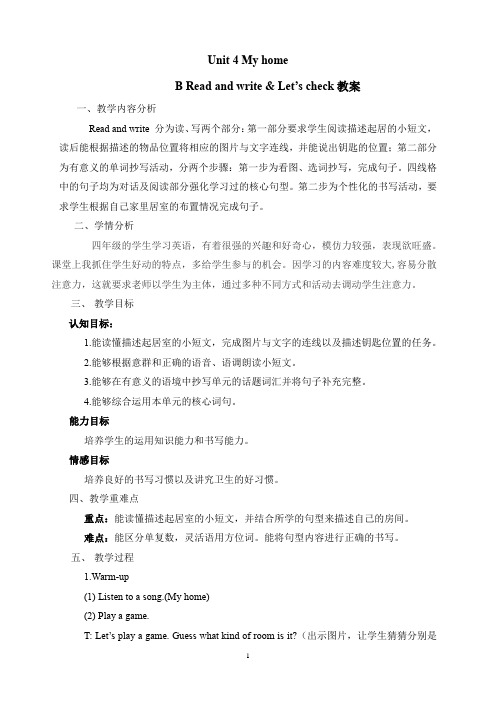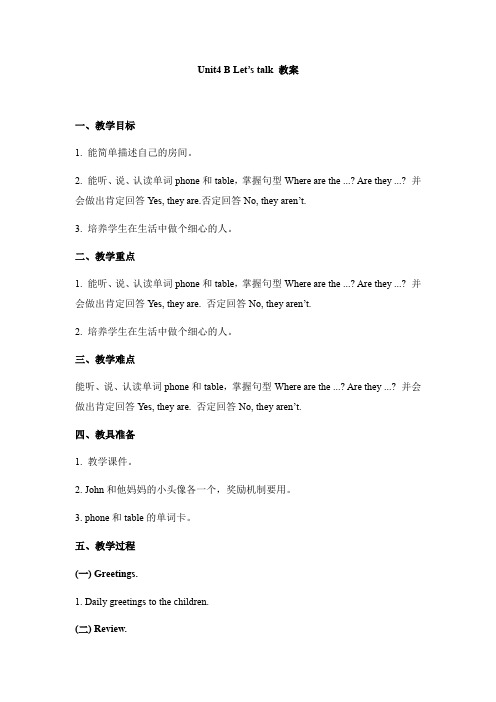人教PEP版-英语-四年级上册-新版PEPunit4 My home B read and write
- 格式:ppt
- 大小:2.92 MB
- 文档页数:14


新2024人教版秋季四年级上册英语《Unit 4 My Home B》教案一、教学目标核心素养:1.知识与技能:1.学生能够掌握描述家居物品位置的词汇和短语,如on the table, in thebedroom等。
2.学生能够运用句型“Where is/are...?”询问物品的位置,并给出相应回答。
2.过程与方法:1.引导学生通过观察图片和实物,学习并理解描述物品位置的词汇和短语。
2.通过小组讨论、角色扮演等活动,培养学生运用所学语言进行实际交流的能力。
3.情感、态度与价值观:1.培养学生热爱家庭、珍惜家庭物品的情感。
2.引导学生养成有条理地整理家庭物品的习惯。
二、教学重点•掌握描述家居物品位置的词汇和短语。
•学会运用句型“Where is/are...?”询问物品的位置,并给出相应回答。
三、教学难点•准确理解和运用描述物品位置的词汇和短语。
•在实际情境中灵活运用所学句型进行交流。
四、教学资源•课本•多媒体课件(包含家居环境图片、物品位置图片)•实物或模型(如家具、玩具等)•单词卡片五、教学方法•直观演示法:通过图片、实物等展示家居物品及其位置,帮助学生理解词汇和短语。
•情景模拟法:创设家庭环境情境,让学生在模拟环境中学习并运用语言。
•角色扮演法:学生扮演家庭成员,进行角色扮演活动,练习运用所学语言进行交流。
六、教学过程1. 复习热身•问候与导入:师生互致问候,通过简单的英语对话复习上节课所学内容。
•快速复习:通过图片或单词卡片快速回顾与家居环境相关的已学词汇和句型。
2. 新课呈现•导入新课:展示家居环境图片,引导学生谈论家中物品的位置,引出新课主题。
•呈现新词汇和短语:教授描述家居物品位置的词汇和短语,如on the table, in the bedroom等。
使用实物或模型帮助学生理解词义,并指导学生正确发音。
•句型教学:教授句型“Where is/are...?”并引导学生学习其回答方式。


Unit 4 My homeB Read and write & Let’s check教案一、教学内容分析Read and write 分为读、写两个部分:第一部分要求学生阅读描述起居的小短文,读后能根据描述的物品位置将相应的图片与文字连线,并能说出钥匙的位置;第二部分为有意义的单词抄写活动,分两个步骤:第一步为看图、选词抄写,完成句子。
四线格中的句子均为对话及阅读部分强化学习过的核心句型。
第二步为个性化的书写活动,要求学生根据自己家里居室的布置情况完成句子。
二、学情分析四年级的学生学习英语,有着很强的兴趣和好奇心,模仿力较强,表现欲旺盛。
课堂上我抓住学生好动的特点,多给学生参与的机会。
因学习的内容难度较大,容易分散注意力,这就要求老师以学生为主体,通过多种不同方式和活动去调动学生注意力。
三、教学目标认知目标:1.能读懂描述起居室的小短文,完成图片与文字的连线以及描述钥匙位置的任务。
2.能够根据意群和正确的语音、语调朗读小短文。
3.能够在有意义的语境中抄写单元的话题词汇并将句子补充完整。
4.能够综合运用本单元的核心词句。
能力目标培养学生的运用知识能力和书写能力。
情感目标培养良好的书写习惯以及讲究卫生的好习惯。
四、教学重难点重点:能读懂描述起居室的小短文,并结合所学的句型来描述自己的房间。
难点:能区分单复数,灵活语用方位词。
能将句型内容进行正确的书写。
五、教学过程1.Warm-up(1) Listen to a song.(My home)(2) Play a game.T: Let’s play a game. Guess what kind of room is it?(出示图片,让学生猜猜分别是什么房间,同时遮住房间的某个物品并进行问答)T:Where is/are…? S: It’s/They’re in/on/under the…引导学生说出句型The …is /are on/in/under the…2. Presentation(1)T: Wu Yifan has a new living room. Let’s go and have a look!(幻灯片出示Wu Yifan 客厅的图片)T: Look!This is Wu Yifan’s living room. What’s in the living room?(让学生初步感知图片内容)T: There are many things in the living room. Glasses,a bag, some booksand some pens. Where are they? Let’s read and tick or cross.a. 教师出示几个关于短文的几个判断题。

Unit4 B Let’s talk 教案一、教学目标1. 能简单描述自己的房间。
2. 能听、说、认读单词phone和table,掌握句型Where are the ...? Are they ...? 并会做出肯定回答Yes, they are.否定回答No, they aren’t.3. 培养学生在生活中做个细心的人。
二、教学重点1. 能听、说、认读单词phone和table,掌握句型Where are the ...? Are they ...? 并会做出肯定回答Yes, they are. 否定回答No, they aren’t.2. 培养学生在生活中做个细心的人。
三、教学难点能听、说、认读单词phone和table,掌握句型Where are the ...? Are they ...? 并会做出肯定回答Yes, they are. 否定回答No, they aren’t.四、教具准备1. 教学课件。
2. John和他妈妈的小头像各一个,奖励机制要用。
3. phone和table的单词卡。
五、教学过程(一) Greetings.1. Daily greetings to the children.(二) Review.1. Warm-up.“Let’s sing”复习与本课有关的旧知,复习已学单词。
2. Lead in.T: This is John’s home. It’s so beautiful. What’s in his home?Ss: There is/are ...复习已学单词,教授新单词phone和table。
(三) Presentation.1. 以猫偷鱼的故事贯穿整堂课,T: Listen, who is coming? Ss: It’s a cat. T: Where is the cat? Is it on the sofa? 让学生做出回答,复习以be动词开头的单数名词一般疑问句以及它的肯定和否定回答方式。

人教版pep(三年级起点)小学四上Unit 4 My home PB Let’s talk 同步练习一、用括号中所给单词的适当形式填空。
1.Let me clean the three ________ ( window ).2.He ______ ( have )two big eyes.3.I like my _________( classroom ).4.There are many ______ ( desk ) in my classroom.5.________ ( Are ) this your living room?二、上下文搭配。
( )1.Go to the living room. A. Have a snack..( )2. Go to the bedroom. B. Take a shower.( )3. Go to the study. C. Watch TV.( )4. Go to the bathroom. D. Have a sleep.( )5. Go to the kitchen. E. Read a book..三、选择。
1、Is this your bedroom ? _______________A. Yes, they are.B. No, they aren’tC. Yes, it is.D. Yes, it isn’t.2、Where are your pens ? _______________A. It’s on the deskB. Yes, it is.C. They are on the deskD. Yes, they are.3、Are the boys in the classroom? _______________A Yes, they aren’t. B. Yes, it is.C. No, it is.D. Yes, they are.4、Where is your mother ? _______________A Yes, he is. B. She is in the home.C. He is in the kitchen.D. Yes, she is.5. Are the keys in the door? Yes, _______________ .A they aren’tB it isn’tC they are6. Where is your sister? She ________in the study.A isB amC are7. What_______ you see in my room ?A doB canC areUnit4 My Home1.根据所给汉语写出相应的英语单词或短语。
Unit 4 My Home (B) Read and WriteI. Teaching Objectives1.Understand and read the texts related to homes and furnishings.2.Learn and use new vocabulary and phrases related to home decoration.3.Improve reading comprehension skills through answering comprehension questions.4.Write short paragraphs describing a home and furnishings using newly learned vocabulary and phrases.II. Teaching Content1.Key Vocabulary and Phrases–bedroom, living room, bathroom, kitchen, study, dining room–bed, sofa, table, chair, bookshelf, wardrobe, mirror–window, door, wall, floor, ceiling, light, curtain2.Reading Comprehension–Students will read a short passage about a home and answer comprehension questions.3.Writing–Students will write a short paragraph describing their own home and furnishings using newly learned vocabulary and phrases.III. Teaching ProceduresStep 1: Greetings and Warm-up1.Greet the class and ask how they are doing.2.Review previously learned vocabulary related to homes and furnishings.3.Show pictures of different rooms in a home and ask students to name them.Step 2: Introduction to New Vocabulary1.Introduce the new vocabulary and phrases related to home decoration using flashcards.2.Demonstrate the pronunciation and spelling of each word and practice with the class.3.Ask students to repeat the words and use them in simple sentences.Step 3: Reading Comprehension1.Read the short passage about a home to the class.2.Explain any unfamiliar words or phrases and ask comprehension questions.3.Allow students to read the passage on their own and answer the comprehension questions in pairs or small groups.4.Check the answers with the class.Step 4: Writing Activity1.Ask students to write a short paragraph describing their own home and furnishings using the newly learned vocabulary and phrases.2.Walk around the classroom and check for understanding and correct any mistakes.3.Ask some students to share their paragraphs with the class.Step 5: Conclusion and Reflection1.Review the new vocabulary and phrases learned in class.2.Ask students to reflect on what they have learned and how they can use it in their daily lives and interactions with others.3.Assign homework to reinforce the new vocabulary and phrases.IV. Homework1.Review and practice the newly learned vocabulary and phrases.2.Write a longer paragraph describing a dream home using the new vocabulary and phrases.3.Read a book or article related to homes or interior design in English.。